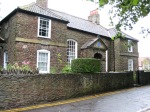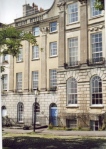When I was researching for Hannah More: the First Victorian (OUP, 2003), my biography of Wilberforce’s friend and the ‘honorary man’ of the Clapham Sect, I was stumped, as her other biographers have been, by the difficulty of filling in the gaps in her early life. A comparison of the humble schoolmaster’s cottage where she was born (left: Hannah, her parents and four sisters were squashed into the left-hand wing) and the elegant house in Clifton where she died (right) makes it clear that she was a remarkable example of late-Georgian social mobility. The later years are well-documented, but the early life far less so.
I looked at the parish records and local newspapers, Hannah More’s letters, and of course consulted earlier secondary works. However, thanks to a meticulously researched and ground-breaking article by William Evans of the University of the West of England, I now know that a lot of what I wrote was inaccurate.
For the full article see William Evans, ‘Hannah More’s Parents’, Transactions of the Bristol & Gloucestershire Archaeological Society 124 (2006), 113-30. This is my summary.
Hannah More’s father Jacob may be the Jacob More who was baptised in Norwich on 17 March 1699. There is no evidence that he attended Norwich Grammar School, as has frequently been asserted, but he may have been educated at a similar institution. The story that he lost money because of litigation over a large estate at Wenhaston cannot be corroborated. There was probably no such estate.
It has not been possible to corroborate the statement of More’s early biographer Henry Thompson that Jacob More was a supervisor of excise in Bristol as the records for the relevant period have nor survived. He may have held a post of which there is no longer a documentary trace, or perhaps a lower post than that of surveyor.
There is no trace in the local records of a Jacob More marrying a Mary Grace, previously believed to have been Hannah More’s mother. However in the records of St Werbergh’s church there is an entry for the marriage by licence on 2 July 1735 of Jacob More and Mary Linch.
The Gloucestershire Archives show that Jacob More was appointed master of the Fishponds school in 1743. The records show that he supplemented his meagre income by land surveying and valuing. In October 1751 Silas Blandford, land steward of the principal landowner, Norborne Berkeley, paid him for drawing a map of Kingswood. He was engaged in similar tasks in subsequent years. Hannah More always retained warm memories of Silas Blandford, whom she seems to have seen as a benevolent guardian of her family.
Jacob More’s tenure of the schoolmaster’s post at Fishponds ended in recriminations. The trustees kept poor records of the payments they made. In 1782, a time when Jacob would have long finished teaching, he was still receiving a salary and he and his wife continued to live in the schoolhouse. Jacob was meant to be paying a shilling a week to each of the two widows who lived in the other wing of the building, but he was paying it to only one. On 26 April 1783, shortly after Jacob’s death, his eldest daughter, Mary, by then a respected schoolmistress, wrote to the trustees of the school to defend her father from the charge of misappropriating the trust money. Her letter contained several inaccuracies, either innocent or intentional.
Evans has unearthed some intriguing information about Hannah More’s mother’s family. Mary Linch (Lynch) was baptised on 29 January 1718 at Stoke Gifford. The Lynches were an established family in the parish. In 1747 Mary’s sister Susannah married as her second husband a carpenter, John Grace (so this is where the name Grace comes in!) at Olveston, a parish five miles from Stoke Gifford, and gave birth to eight children. I note in my book Hannah More’s reference to the death of her ‘poor afflicted aunt’ in 1794. It is possible that Hannah More commissioned her memorial stone, a gesture she did not accord her parents.
These findings raise the intriguing question of why Hannah More, whether intentionally or not, obfuscated the details about her family. By the time she was middle-aged, she was mixing with the gentry, the aristocracy, and even royalty. Perhaps she did not wish to be reminded too much that she was the daughter of a poor schoolmaster, who could not keep accounts and might even have defrauded a poor widow of the meagre sum that was owing to her.

